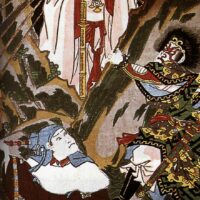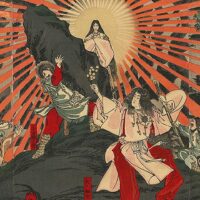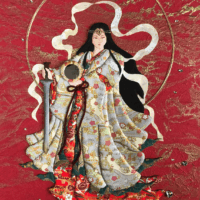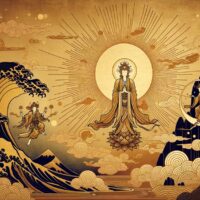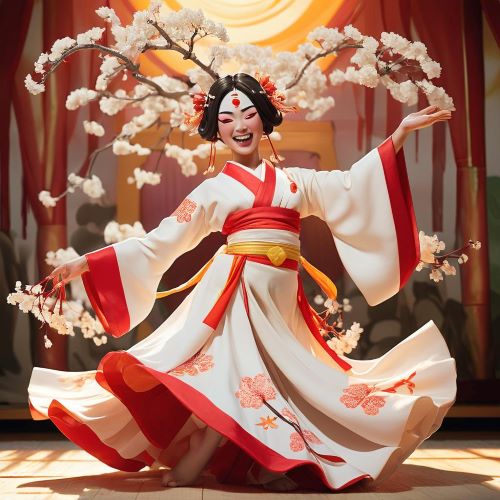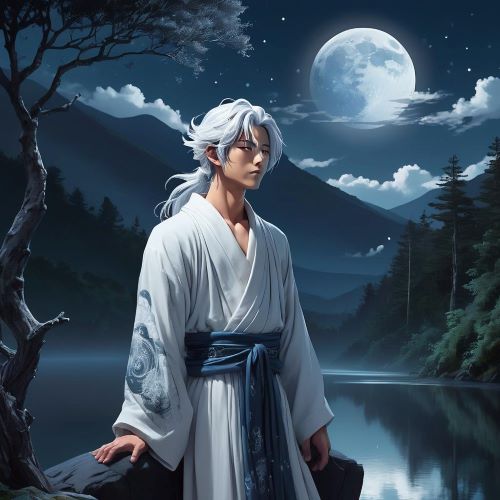Amaterasu : The Sun Goddess
Listen
Amaterasu
Introduction
Amaterasu Omikami, known simply as Amaterasu, is a pivotal figure in Japanese mythology, embodying the sun and holding supreme reign in the Shinto pantheon. Her story intertwines with Japan’s creation and imperial lineage, imparting enduring cultural significance. Revered as the luminous deity of the sun, her name translates to “shining in heaven,” and she occupies a central role in Shinto beliefs as the ruler of Takamagahara, the heavenly realm. Claimed as an ancestor by the Japanese Imperial Family, she bestows divine authority upon them. Amaterasu is the majestic sun goddess of Japanese mythology, embodying light, harmony, and prosperity in Shintoism, Japan’s native religion. Her influence spans across millennia, shaping spiritual beliefs and cultural identity.
Physical Traits
Amaterasu is portrayed as a radiant and benevolent figure, often depicted with a serene countenance and shimmering robes that evoke sunlight. Her presence brings warmth and comfort, akin to the gentle touch of the morning sun. Artists and storytellers use celestial symbols like mirrors or jeweled necklaces to represent her clarity and purity. Unlike some deities with defined physical forms, Amaterasu’s depiction is often symbolic. She is represented by the rising sun itself, radiating warmth and light throughout the heavens. Shinto art portrays her indirectly through mirrors, polished metals, or jeweled objects that reflect her brilliance. Occasionally depicted as a woman of extraordinary beauty, adorned in flowing robes with long, radiant hair, her celestial nature transcends any fixed physical form. Amaterasu embodies the essence of the rising sun, symbolizing life, warmth, and vitality across diverse artistic interpretations.
Family
Amaterasu’s family lineage is pivotal in Japanese mythology, intricately weaving her into the fabric of divine creation. Born from Izanagi, the god of life, she emerged from his left eye, alongside Tsukuyomi from his right eye and Susanoo from his nose. While Amaterasu shares a harmonious bond with Tsukuyomi, symbolizing the balance of day and night, her relationship with Susanoo is marked by conflict due to his disruptive nature. These familial dynamics shape pivotal moments in her mythological narrative. As a daughter of Izanagi and Izanami, the primordial deities who shaped Japan, Amaterasu’s lineage ties her closely to other significant gods like Susanoo and Tsukuyomi. Their interactions and conflicts reflect broader themes of creation, cosmic order, and the natural forces that govern the universe. Through her grandson Ninigi, she establishes a mythical lineage that connects her profoundly to the Imperial House of Japan.
Other names
Amaterasu Ōmikami is known by several names that highlight her solar nature and divine role. Referred to as Ōhirume-no-Muchi, meaning “great day female,” she emphasizes her association with daylight. Another title, Hi-no-Kami, translates to “sun deity,” underscoring her embodiment of the sun’s radiance. These various appellations across different contexts and regions illustrate Amaterasu’s multifaceted significance. In Shinto traditions, she is often simply called Ōmikami, meaning “Great Goddess,” a title that reflects her central position in Japanese spiritual beliefs and cultural identity, particularly as the supreme sun deity.
Powers and Abilities
Amaterasu, as the sun goddess, holds immense power over the natural world. She governs the cycle of day and night, ensuring warmth, light, and growth for all living things. Farmers rely on her blessings for abundant harvests, underscoring her association with agriculture, prosperity, and the renewal of life. One of the most striking demonstrations of her power is seen in the myth of the Heavenly Rock Cave. When angered by Susanoo’s destructive actions, Amaterasu retreated into a cave, casting the world into darkness and triggering a profound crisis. This episode vividly illustrates her crucial role in maintaining cosmic balance and harmony. Eventually coaxed out by the other gods, she restored light and order, reaffirming her pivotal influence over the well-being of the world.
Amaterasu’s power transcends mere illumination; it encompasses realms of protection, fertility, and the preservation of cosmic order. As the sun goddess, her radiance is not just physical but spiritual, imbuing existence with harmony and prosperity. Legends recount her pivotal role in vanquishing chaos and darkness, her brilliance dispelling malevolent forces and restoring equilibrium. Her sacred mirror, a symbol of truth and introspection, holds profound significance in warding off evil and revealing hidden truths. Amaterasu’s withdrawal into Ama-no-Iwato, the Heavenly Rock Cave, due to her brother Susanoo’s tumultuous behavior plunged the world into darkness; her return brought forth light and renewed hope to all.
Modern Day Influence
Amaterasu’s legacy spans beyond ancient myths, resonating deeply in contemporary Japanese culture. The Imperial House of Japan traces its lineage to her, affirming her integral role in the nation’s identity. Revered Shinto shrines throughout Japan, including the Ise Grand Shrine, draw millions annually, symbolizing her enduring spiritual importance. Her image adorns everything from amulets to the national flag, embodying her influence in daily life. In modern media, from anime to video games, Amaterasu continues to captivate as a symbol of courage and redemption. Artists and writers draw inspiration from her timeless qualities, reflecting her ongoing impact on cultural expression and spiritual devotion.
Related Images
Sources
Aston, W. G. (Trans.). (2005). Nihongi: Chronicles of Japan from the earliest times to A.D. 697. Tuttle Publishing. (Original work published 1896)
Encyclopedia.pub. (n.d.). Amaterasu. In Encyclopedia.pub. Retrieved August 9, 2025, from https://encyclopedia.pub/entry/32198
Girl Museum. (n.d.). Mythological girls: Amaterasu. GirlMuseum.org. Retrieved August 9, 2025, from https://www.girlmuseum.org/mythological-girls-amaterasu/
Mythology Source. (n.d.). Amaterasu: Japanese goddess of the sun. MythologySource.com. Retrieved August 9, 2025, from https://mythologysource.com/amaterasu-japanese-goddess/
Nippon.com. (2021, August 17). Amaterasu: The Japanese sun goddess. Nippon.com. Retrieved August 9, 2025, from https://www.nippon.com/en/japan-topics/g00748/amaterasu-the-japanese-sun-goddess.html
Ō no Yasumaro. (1981). Kojiki (D. Lurie, Trans.). Princeton University Press. (Original work published 712)
SpringerLink. (n.d.). Amaterasu. In Encyclopedia of Mythology. Springer Nature. Retrieved August 9, 2025, from https://link.springer.com/rwe/10.1007/978-3-030-24348-7_200028
Wikipedia contributors. (2025, August 7). Amaterasu. In Wikipedia. Retrieved August 9, 2025, from https://en.wikipedia.org/wiki/Amaterasu
Frequently Asked Questions
Who is Amaterasu in Japanese mythology?
Amaterasu is the Shinto sun goddess and one of the most important deities in Japanese mythology. She is revered as the ruler of the heavens and the ancestor of Japan’s imperial family. According to the Kojiki and Nihon Shoki, she was born from the left eye of the creator god Izanagi during a purification ritual.
What is the story of Amaterasu hiding in the cave?
In one of Japan’s most famous myths, Amaterasu retreats into the Heavenly Rock Cave (Amano-Iwato) after a quarrel with her brother Susanoo, plunging the world into darkness. The other gods lured her out by staging a joyful celebration, and when she peeked out, they revealed a mirror. Curious, she emerged, restoring light to the world.
Why is Amaterasu important in Shinto religion?
Amaterasu is central to Shinto belief as the embodiment of light, order, and life. She symbolizes purity, harmony, and the divine connection between nature and humanity. As the mythic ancestor of Japan’s emperors, she also underpins the spiritual and cultural legitimacy of the imperial line.
Is Amaterasu the ancestor of the Japanese imperial family?
Yes. Shinto tradition holds that the first emperor of Japan, Emperor Jimmu, was a direct descendant of Amaterasu through her grandson Ninigi-no-Mikoto. This divine lineage has historically been used to reinforce the sacred status of the Japanese imperial family.
What symbols and shrines are associated with Amaterasu?
Amaterasu is often represented by the rising sun, mirrors, and the sacred Yata no Kagami mirror. Her most important shrine is the Ise Grand Shrine in Mie Prefecture, considered the holiest site in Shinto. Pilgrimages to Ise are seen as a way to honor her and seek blessings.



